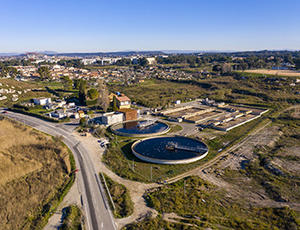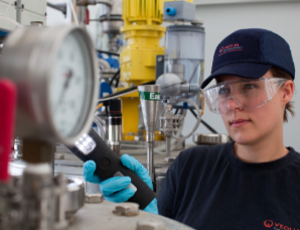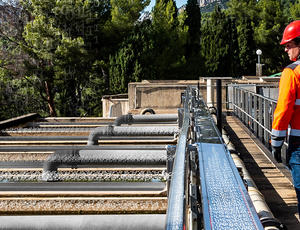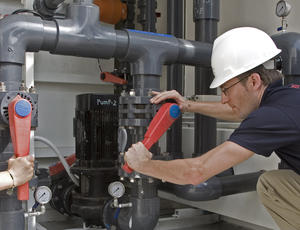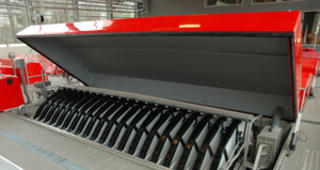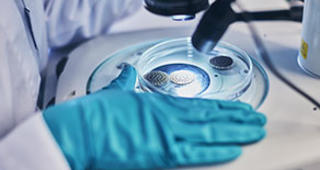Cella™ is a new biofilm technology for efficient and sustainable wastewater treatment.
Overview
Cella is a new biofilm technology developed with a strong emphasis on sustainability, reuse and ensuring clean water for future generations. Designed to maximize energy efficiency and recovery in the form of biogas from excess biomass, Cella promotes a positive energy balance in treatment plants. Furthermore, this technology facilitates the integration of biological phosphorus removal into the treatment process, reducing reliance on chemicals for phosphate precipitation.
How does Cella™ work?
Cella features the Moving Bed Biofilm Reactor (MBBR) technology while incorporating additional benefits, including a new biobased support material for biofilm growth, no limitation in biofilm surface with high treatment rates, and an all-in-one solution for the treatment of carbon, nitrogen and phosphorus. The exposed surface facilitates efficient mass transfer into and out of the biofilm, resulting in a highly effective process that can handle high loading rates within a small footprint.
Cella combines the flexibility of the activated sludge process with the compactness and stability of biofilm processes – in one and the same tank.

Features and benefits

A valuable resource for municipalities
On the path towards decarbonization

Minimizes the use of fossil-based resources
Permits the integration of circular economy principles in biofilm-based biotreatment

Maximizes energy efficiency and recovery
Biogas from excess biomass, promoting a positive energy balance in treatment plants

Facilitates the integration of biological phosphorus removal
Reducing reliance on chemicals for phosphate precipitation

Flexible, simple and robust operation
Support material provides a large exposed surface area for biofilm growth due to its small size within the millimeter range, leading to the effortless transfer of contaminants and products into and out of the biofilm

All-in-one solution
Simultaneous biological treatment of carbon, nitrogen and phosphorus

Efficient process
Handles high loading rates in a small footprint, meeting stringent discharge requirements
Applications
Services
We offer a large range of services.
Contact
Municipalities worldwide are facing the need to increase the efficiency of their wastewater treatment plants without compromising on greenhouse gas emissions, compactness, and energy neutrality. Cella does more than that. We intensified our commitment and cooperation with nature by developing an efficient biofilm technology that incorporates the key pillars of the circular economy.

Luca Quadri
Sales Director at Veolia Water Technologies - AnoxKaldnes
Contact Luca through his LinkedIn account
FAQ about Cella
What are the benefits of biological treatment?
Wastewater biological treatment offers various benefits, including the efficient elimination of contaminants that has a favorable impact on the environment. The financial impact of the process is also reduced, as biological treatment is cheaper than physical chemical treatments.
AnoxKaldnes' Cella™ technology utilizes nature's power to improve sustainable wastewater treatment at a low cost, with a high quality result, and with a minimal footprint.
How is the biofilm in CellaTM used for wastewater treatment?
Cella is a technology in which microorganisms grow on the external surface of a support material , resulting in the creation of a biofilm. These microorganisms thrive from removing contaminants from wastewater which they use as a food source. By removing these contaminants, microorganisms clean the wastewater to the required treatment parameters. Some of these organisms require very specific conditions which are ensured in a biofilm and the biofilm protects them from external inhibitory conditions.
In the biofilm, microorganisms can grow in layers or zones under different conditions depending on the biofilm thickness (aerobic, anoxic, anaerobic), which allows for an efficient all-in-one treatment of carbon, nitrogen and phosphorus.
Cella™ is a new biofilm technology for efficient and sustainable wastewater treatment.
How does biological phosphorus removal work?
Biological phosphorus removal takes place in the biofilm by promoting the growth of phosphorus-accumulating bacteria under anaerobic and aerobic conditions with the availability of easily degradable carbon.
In CellaTM, phosphorus accumulates inside the microorganisms in the biofilm, and due to natural biofilm sloughing, excess biomass containing phosphorus exits the process in the form of suspended solids. After downstream effluent suspended solids separation, the wastewater leaving the treatment process contains the desired low phosphorus levels.
Case Studies

The municipal wastewater treatment plant, Svinninge, located in Holbᴂk is an activated sludge plant mainly receiving wastewater from households and a few industries. Working beyond its permissible capacity, the client needed to increase the existing plant’s capacity to ensure effective treatment. In order to meet our client’s needs, Cella was chosen, this decision having been driven by the technology’s sustainability and small ecological footprint as well as the compactness and efficiency of its process.



